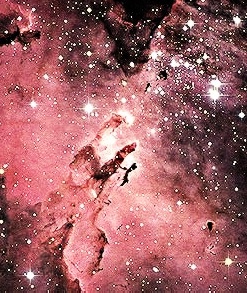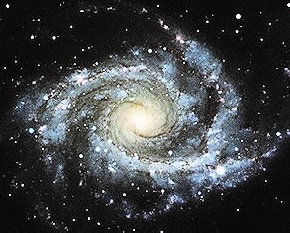
MPIA Workshop on
MODES OF STAR FORMATION
and the Origin of Field Star Populations
Date:
October 9 to 13, 2000
Venue:
Max Planck Institute
for Astronomy, Heidelberg, Germany
Sponsor:
Max Planck Society
Organizer:
Eva K. Grebel
Scientific Rationale:
The workshop will focus at discussing the different modes of star
formation observed in the local Universe with the goal of identifying
the dominant processes and their preconditions. In particular, the
origin and evolution of field populations will be contrasted with
cluster formation and evolution.
 Recent advances in instrumentation and theory are greatly improving
our understanding of star formation processes and different modes of
star formation. HIPPARCOS helped to identify new moving groups and
to connect open clusters with larger associations in the solar
neighborhood. Future astrometric missions (DIVA, FAME, SIM, GAIA)
will allow us to trace the kinematic evolution from clusters to field
populations with even greater accuracy and over much larger distances.
HST has led to impressive advances in the understanding of the low-mass
mass function through proper-motion separation of individual globular
cluster members from field stars. HST and VLT are unveiling detailed
star formation processes and IMF variations in giant HII regions and
starburst clusters ranging from the Galactic center to nearby galaxies.
SOFIA and NGST as well as ground-based infrared instrumentation and
adaptive optics will facilitate high-spatial resolution studies of
deeply embedded clusters and ultra-compact HII regions in the very
early stages of formation. NANTEN is uncovering the evolution of
molecular clouds and the ISM during and after star formation. ALMA will
provide unique insights in the initial conditions of the formation of
clusters and associations in a wide range of galactic environments out
to distances of 100 Mpc. These observational advances are accompanied
by significant progress in the theoretical understanding of different
modes of star formation including the fragmentation of molecular clouds,
the evolution of the stellar mass spectrum, large-scale star-formation
processes, and kinematic evolution and dissolution.
Recent advances in instrumentation and theory are greatly improving
our understanding of star formation processes and different modes of
star formation. HIPPARCOS helped to identify new moving groups and
to connect open clusters with larger associations in the solar
neighborhood. Future astrometric missions (DIVA, FAME, SIM, GAIA)
will allow us to trace the kinematic evolution from clusters to field
populations with even greater accuracy and over much larger distances.
HST has led to impressive advances in the understanding of the low-mass
mass function through proper-motion separation of individual globular
cluster members from field stars. HST and VLT are unveiling detailed
star formation processes and IMF variations in giant HII regions and
starburst clusters ranging from the Galactic center to nearby galaxies.
SOFIA and NGST as well as ground-based infrared instrumentation and
adaptive optics will facilitate high-spatial resolution studies of
deeply embedded clusters and ultra-compact HII regions in the very
early stages of formation. NANTEN is uncovering the evolution of
molecular clouds and the ISM during and after star formation. ALMA will
provide unique insights in the initial conditions of the formation of
clusters and associations in a wide range of galactic environments out
to distances of 100 Mpc. These observational advances are accompanied
by significant progress in the theoretical understanding of different
modes of star formation including the fragmentation of molecular clouds,
the evolution of the stellar mass spectrum, large-scale star-formation
processes, and kinematic evolution and dissolution.
 The most conspicuous present-day star formation events occur in giant
molecular clouds, which form either extended unbound associations and
complexes, open clusters, or compact starburst clusters. For example,
in spirals like the Milky Way we typically observe the formation of
large associations in molecular clouds along the spiral arms, while the
Magellanic Clouds have also been forming hundreds of compact "populous"
clusters. The formation of super star clusters (potential progenitors
of globular clusters) remains a rare phenomenon in the local Universe,
possibly confined to very massive giant HII regions and nuclear
starburst regions. Studies of resolved starburst regions reveal that
star formation there is not an instantaneous event but occurs over
several generations distinct in age and spatial distribution.
The most conspicuous present-day star formation events occur in giant
molecular clouds, which form either extended unbound associations and
complexes, open clusters, or compact starburst clusters. For example,
in spirals like the Milky Way we typically observe the formation of
large associations in molecular clouds along the spiral arms, while the
Magellanic Clouds have also been forming hundreds of compact "populous"
clusters. The formation of super star clusters (potential progenitors
of globular clusters) remains a rare phenomenon in the local Universe,
possibly confined to very massive giant HII regions and nuclear
starburst regions. Studies of resolved starburst regions reveal that
star formation there is not an instantaneous event but occurs over
several generations distinct in age and spatial distribution.
At this workshop we will concentrate on the following questions:
Which processes govern the differing star formation efficiencies and
modes of star formation? To what extent does galaxy environment play
a role? How do star formation processes in galaxies of different
morphological types, masses, gas content, rotation patterns, and in
presence or absence of interactions compare? What are the implications
for galaxy formation and evolution?
What are the spatial scales over which star formation typically occurs,
and how do they depend on environment and location? Over what time
scales does star formation occur within a given region? Are external
trigger mechanisms required? Why isn't present-day globular cluster
formation common?
Do field populations in galaxies generally originate in gradually
dispersing associations and from dissolved open clusters? Can star
formation occur in "isolation" in the field, and if so what range of
masses can be formed this way, and how common is this process? How
does the initial mass function depend on environment and formation
conditions?
This workshop aims at discussing these issues by placing particular
emphasis on recent results from galaxies in the nearby universe, where
different modes of star formation can be studied in great detail.
Links:
|
SOC & LOC
Shipping addresses
Travel and
hotels
|
|
Eva K. Grebel
|

Recent advances in instrumentation and theory are greatly improving our understanding of star formation processes and different modes of star formation. HIPPARCOS helped to identify new moving groups and to connect open clusters with larger associations in the solar neighborhood. Future astrometric missions (DIVA, FAME, SIM, GAIA) will allow us to trace the kinematic evolution from clusters to field populations with even greater accuracy and over much larger distances. HST has led to impressive advances in the understanding of the low-mass mass function through proper-motion separation of individual globular cluster members from field stars. HST and VLT are unveiling detailed star formation processes and IMF variations in giant HII regions and starburst clusters ranging from the Galactic center to nearby galaxies. SOFIA and NGST as well as ground-based infrared instrumentation and adaptive optics will facilitate high-spatial resolution studies of deeply embedded clusters and ultra-compact HII regions in the very early stages of formation. NANTEN is uncovering the evolution of molecular clouds and the ISM during and after star formation. ALMA will provide unique insights in the initial conditions of the formation of clusters and associations in a wide range of galactic environments out to distances of 100 Mpc. These observational advances are accompanied by significant progress in the theoretical understanding of different modes of star formation including the fragmentation of molecular clouds, the evolution of the stellar mass spectrum, large-scale star-formation processes, and kinematic evolution and dissolution.
The most conspicuous present-day star formation events occur in giant molecular clouds, which form either extended unbound associations and complexes, open clusters, or compact starburst clusters. For example, in spirals like the Milky Way we typically observe the formation of large associations in molecular clouds along the spiral arms, while the Magellanic Clouds have also been forming hundreds of compact "populous" clusters. The formation of super star clusters (potential progenitors of globular clusters) remains a rare phenomenon in the local Universe, possibly confined to very massive giant HII regions and nuclear starburst regions. Studies of resolved starburst regions reveal that star formation there is not an instantaneous event but occurs over several generations distinct in age and spatial distribution.